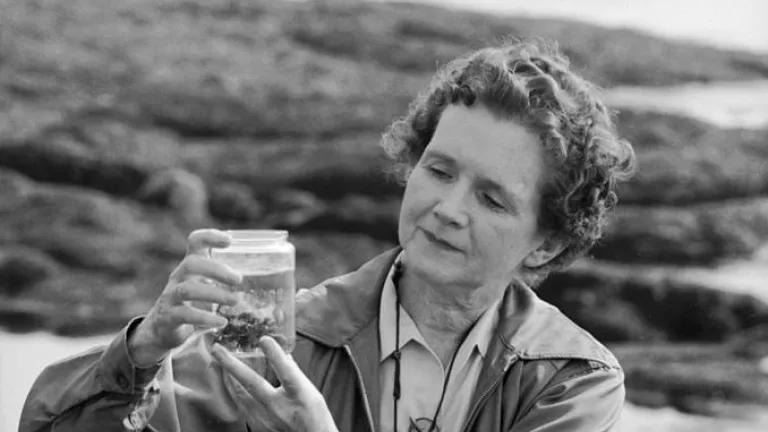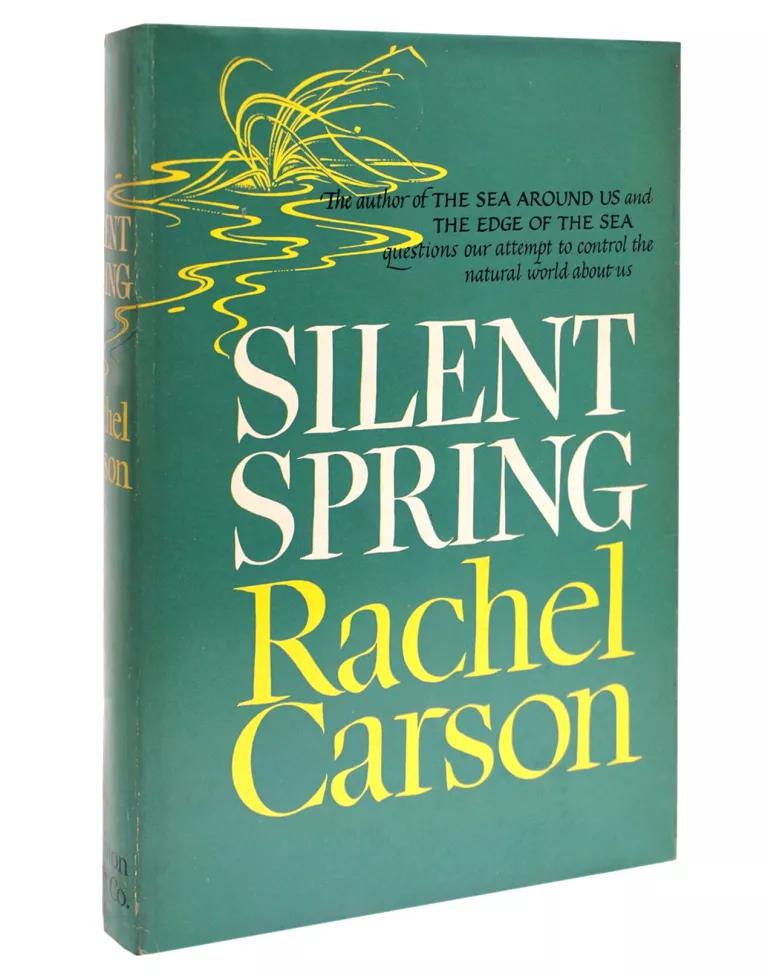The Story of Silent Spring
How a courageous woman took on the chemical industry and raised important questions about humankind's impact on nature.

Rachel Carson on a beach in Maryland
Alfred Eisenstaedt/LIFE Picture Collection via Shutterstock
Although they will probably always be less celebrated than wars, marches, riots, or stormy political campaigns, books have at times been the most powerful influencer of social change in American life. Thomas Paine's Common Sense galvanized radical sentiment in the early days of the Revolution; Uncle Tom's Cabin by Harriet Beecher Stowe roused the North's antipathy to slavery in the decade leading up to the Civil War; and Rachel Carson's Silent Spring, which in 1962 exposed the hazards of the pesticide DDT, eloquently questioned humanity's faith in technological progress and helped set the stage for the environmental movement.
Carson, a renowned nature author and a former marine biologist with the U.S. Fish and Wildlife Service, or FWS, was uniquely equipped to create so startling and inflammatory a book. A native of rural Pennsylvania, she had grown up with an enthusiasm for nature matched only by her love of writing and poetry. The educational brochures she wrote for FWS, as well as her published books and magazine articles, were characterized by meticulous research and a poetic evocation of her subject.
"Things go out of kilter"
Carson was happiest writing about the strength and resilience of natural systems. Her books Under the Sea Wind, The Sea Around Us (which stayed on the New York Times best-seller list for 86 weeks), and The Edge of the Sea were hymns to the interconnectedness of nature and all living things. Although she rarely used the term, Carson held an ecological view of nature, describing in precise yet poetic language the complex web of life that linked mollusks to seabirds to the fish swimming in the ocean's deepest and most inaccessible reaches.
DDT, the most powerful pesticide the world had ever known, exposed nature's vulnerability. Unlike most pesticides, whose effectiveness is limited to destroying one or two types of insects, DDT was capable of killing hundreds of different kinds at once. Developed in 1939, it first distinguished itself during World War II, clearing South Pacific islands of malaria-causing insects for U.S. troops while being used as an effective delousing powder in Europe. Its inventor was awarded the Nobel Prize.
When DDT became available for civilian use in 1945, there were only a few people who expressed second thoughts about this new miracle compound. One was nature writer Edwin Way Teale, who warned, "A spray as indiscriminate as DDT can upset the economy of nature as much as a revolution upsets social economy. Ninety percent of all insects are good, and if they are killed, things go out of kilter right away." Another was Carson, who wrote to Reader's Digest to propose an article about a series of tests on DDT being conducted not far from where she lived in Maryland. The magazine rejected the idea.
Silent Spring

Alfred Eisenstaedt/LIFE Picture Collection via Shutterstock
Silent Spring took Carson four years to complete. It meticulously described how DDT entered the food chain and accumulated in the fatty tissues of animals, including human beings, and caused cancer and genetic damage. A single application on a crop, she wrote, killed insects for weeks and months—not only the targeted insects but countless more—and remained toxic in the environment even after it was diluted by rainwater. Carson concluded that DDT and other pesticides had irrevocably harmed animals and had contaminated the world's food supply. The book's most haunting and famous chapter, "A Fable for Tomorrow," depicted a nameless American town where all life—from fish to birds to apple blossoms to human children—had been "silenced" by the insidious effects of DDT.
First serialized in The New Yorker in June 1962, the book alarmed readers across America and, not surprisingly, brought a howl of indignation from the chemical industry. "If man were to faithfully follow the teachings of Miss Carson," complained an executive of the American Cyanamid Company, "we would return to the Dark Ages, and the insects and diseases and vermin would once again inherit the earth." Monsanto published and distributed 5,000 copies of a brochure parodying Silent Spring entitled "The Desolate Year," relating the devastation and inconvenience of a world where famine, disease, and insects ran amok because chemical pesticides had been banned. Some of the attacks were more personal, questioning Carson's integrity and even her sanity.
Vindication
Her careful preparation, however, had paid off. Anticipating the reaction of the chemical industry, she had compiled Silent Spring as one would a lawyer's brief, with no fewer than 55 pages of notes and a list of experts who had read and approved the manuscript. Many eminent scientists rose to her defense, and when President John F. Kennedy ordered the President's Science Advisory Committee to examine the issues the book raised, its report thoroughly vindicated both Silent Spring and its author. As a result, DDT came under much closer government supervision and was eventually banned. The public debate moved quickly from whether pesticides were dangerous to which ones were dangerous, and the burden of proof shifted from the opponents of unrestrained pesticide use to the manufacturers.
The most important legacy of Silent Spring, though, was a new public awareness that nature was vulnerable to human intervention. Carson had made a radical proposal: that, at times, technological progress is so fundamentally at odds with natural processes that it must be curtailed. Conservation had never raised much broad public interest, for few people really worried about the disappearance of wilderness. But the threats Carson had outlined—the contamination of the food chain, cancer, genetic damage, the deaths of entire species—were too frightening to ignore. For the first time, the need to regulate industry in order to protect the environment became widely accepted, and environmentalism was born.
Carson was well aware of the larger implications of her work. Appearing on a CBS documentary about Silent Spring shortly before her death from breast cancer in 1964, she remarked, "Man's attitude toward nature is today critically important simply because we have now acquired a fateful power to alter and destroy nature. But man is a part of nature, and his war against nature is inevitably a war against himself? [We are] challenged as mankind has never been challenged before to prove our maturity and our mastery, not of nature, but of ourselves."
One of the landmark books of the 20th century, Silent Spring's message resonates loudly today, even several decades after its publication. And equally inspiring is the example of Rachel Carson herself. Against overwhelming difficulties and adversity, but motivated by her unabashed love of nature, she rose like a gladiator in its defense.
This NRDC.org story is available for online republication by news media outlets or nonprofits under these conditions: The writer(s) must be credited with a byline; you must note prominently that the story was originally published by NRDC.org and link to the original; the story cannot be edited (beyond simple things such as grammar); you can’t resell the story in any form or grant republishing rights to other outlets; you can’t republish our material wholesale or automatically—you need to select stories individually; you can’t republish the photos or graphics on our site without specific permission; you should drop us a note to let us know when you’ve used one of our stories.

Neonicotinoids 101: The Effects on Humans and Bees
A Growing Concern: Microplastic Pollution on Farm Fields
Murder Hornets Are Scary. But Pesticides Are Scarier.